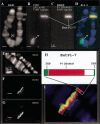Construction and transposition of a 100-kilobase extended P element in Drosophila
- PMID: 11042158
- PMCID: PMC310958
- DOI: 10.1101/gr.151700
Construction and transposition of a 100-kilobase extended P element in Drosophila
Abstract
We have used P element deletion derivatives at defined locations in the Drosophila genome to construct a 100-kb extended P element more than twice the size of any previously available. We demonstrate that this prototypical extended P element is capable of transposition to new sites in the genome. The structural and functional integrity of a transposed extended P element was confirmed using molecular, genetic, and cytogenetic criteria. This is the first method shown to be capable of producing large, unlinked transpositional duplications in Drosophila. The ability to produce functional transposable elements from half-elements is novel and has many potential applications for the functional analysis of complex genomes.
Figures





Similar articles
-
Systematic gene targeting on the X chromosome of Drosophila melanogaster.Chromosoma. 2004 Dec;113(6):271-5. doi: 10.1007/s00412-004-0313-5. Epub 2004 Oct 12. Chromosoma. 2004. PMID: 15480728
-
Comparison of two active HeT-A retroposons of Drosophila melanogaster.Chromosoma. 1994 Apr;103(2):90-8. doi: 10.1007/BF00352317. Chromosoma. 1994. PMID: 8055715
-
Characterization of MR (P) strains of Drosophila melanogaster: the number of intact P elements and their genetic effect.Genet Res. 1991 Dec;58(3):211-23. doi: 10.1017/s0016672300029967. Genet Res. 1991. PMID: 1666390
-
Gross chromosome rearrangements mediated by transposable elements in Drosophila melanogaster.Bioessays. 1994 Apr;16(4):269-75. doi: 10.1002/bies.950160410. Bioessays. 1994. PMID: 8031304 Review.
-
Insertional mutagenesis of the Drosophila genome with single P elements.Science. 1988 Mar 4;239(4844):1121-8. doi: 10.1126/science.2830671. Science. 1988. PMID: 2830671 Review.
Cited by
-
Technology transfer from worms and flies to vertebrates: transposition-based genome manipulations and their future perspectives.Genome Biol. 2007;8 Suppl 1(Suppl 1):S1. doi: 10.1186/gb-2007-8-s1-s1. Genome Biol. 2007. PMID: 18047686 Free PMC article. Review.
-
Giant Transposons in Eukaryotes: Is Bigger Better?Genome Biol Evol. 2019 Mar 1;11(3):906-918. doi: 10.1093/gbe/evz041. Genome Biol Evol. 2019. PMID: 30796812 Free PMC article. Review.
References
-
- Ashburner M. Drosophila: a laboratory manual. Cold Spring Harbor: Cold Spring Harbor Laboratory; 1989.
-
- Bass HW, Riera-Lizarazu O, Ananiev EV, Bordoli SJ, Rines HW, Phillips RL, Sedat JW, Agard DA, Cande WZ. Evidence for the coincident initiation of homolog pairing and synapsis during the telomere-clustering (bouquet) stage of meiotic prophase. J Cell Sci. 2000;113:1033–1042. - PubMed
-
- Beall EL, Rio DC. Drosophila IRBP/Ku p70 corresponds to the mutagen-sensitive mus309 gene and is involved in P-element excision in vivo. Genes & Dev. 1996;10:921–933. - PubMed
-
- Bier E, Jan LY, Jan YN. rhomboid, a gene required for dorsoventral axis establishment and peripheral nervous system development in Drosophila melanogaster. Genes & Dev. 1990;4:190–203. - PubMed
Publication types
MeSH terms
Substances
Grants and funding
LinkOut - more resources
Full Text Sources
Molecular Biology Databases
